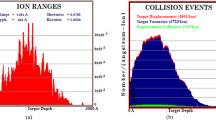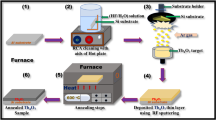Abstract
Multilayer ZrN/SiNx and CrN/SiNx coatings are formed using the method of magnetron sputtering by the consecutive sputtering of Zr (Cr) and Si3N4 targets upon a variation in the thickness of an individual layer from 2 to 10 nm at a substrate temperature of 300°C (ZrN/SiNx system) and 450°C (CrN/SiNx system). X-ray diffraction analysis demonstrates that multilayer ZrN/SiNx and CrN/SiNx coatings consist of nanocrystalline ZrN (CrN) layers with the preferred orientation (002) and amorphous SiNx layers. The lattice parameters of the metal nitride phase for the ZrN/SiNx and CrN/SiNx films are greater than for monolytic ZrN and CrN layers, respectively, and, in the case of ZrN/SiNx films, the lattice parameter increases upon a reduction of the ratio of ZrN to SiNx elementary-layer thicknesses, which can be associated with the growth of compressive stress. As wavelength dispersive X-ray spectrometry of the film composition and scanning electron microscopy of the surface show, the multilayer ZrN/SiNx and CrN/SiNx coatings are more resistant to high-temperature oxidation (in the temperature range of 400–950°C) in comparison with the ZrN and CrN coatings. This resistance increases upon a decrease in the ratio of the thickness of the ZrN individual layer to that of the SiNx individual layer as well as upon an increase in the quantity of layers in the film. However, these factors are not so deciding in the case of CrN/SiNx system. In general, CrN/SiNx coatings are more stable than ZrN/SiNx coatings under the conditions of high-temperature oxidation.







Similar content being viewed by others
REFERENCES
G. Abadias, L. E. Koutsokeras, A. Siozios, and P. Patsalas, Thin Solid Films 538, 56 (2013). https://doi.org/10.1016/j.tsf.2012.10.119
H. C. Barshilia, B. Deepthi, A. S. Arun Prabhu, and K. S. Rajam, Surf. Coat. Technol. 201, 329 (2006). https://doi.org/10.1016/j.surfcoat.2005.11.124
S. G. Harris, E. D. Doyle, A. C. Vlasveld, et al., Wear 254, 723 (2003). https://doi.org/10.1016/S0043-1648(03)00258-8
L. Chen, L. He, Y. Xu, et al., Surf. Coat. Technol. 244, 87 (2014). https://doi.org/10.1016/j.surfcoat.2014.01.063
C. M. Koller, R. Hollerweger, C. Sabitzer, et al., Surf. Coat. Technol. 259, 599 (2014). https://doi.org/10.1016/j.surfcoat.2014.10.024
M. Pfeiler, G. A. Fontalvo, J. Wagner, et al., Tribol. Lett. 30, 91 (2008). https://doi.org/10.1007/s11249-008-9313-6
M. Stueber, U. Albers, H. Leiste, et al., Surf. Coat. Technol. 200, 6162 (2006). https://doi.org/10.1016/j.surfcoat.2005.11.012
R. Wei, C. Rincon, and E. Langa, J. Vac. Sci. Technol., A 28 (5), 1126 (2010). https://doi.org/10.1116/1.3463709
H. C. Barshilia, B. Deepthi, and K. S. Rajam, Surf. Coat. Technol. 201, 9468 (2007). https://doi.org/10.1016/j.surfcoat.2007.04.002
Y. H. Cheng, T. Browne, B. Heckerman, and E. I. Meletis, Surf. Coat. Technol. 204, 2123 (2010). https://doi.org/10.1016/j.surfcoat.2009.11.034
Y.-I. Chen, Y.-X. Gao, and L.-C. Chang, Surf. Coat. Technol. 332, 72 (2017). https://doi.org/10.1016/j.surfcoat.2017.09.087
K. Yalamanchili, I. C. Schramm, E. Jiménez-Piqué, et al., Acta Mater. 89, 22 (2015). https://doi.org/10.1016/j.actamat.2015.01.066
T. Weirather, K. Chladil, B. Sartory, et al., Surf. Coat. Technol. 257, 48 (2014). https://doi.org/10.1016/j.surfcoat.2014.06.018
X. Bai, W. Zheng, T. An, and Q. Jiang, J. Phys.: Condens. Matter 17, 6405 (2005). https://doi.org/10.1088/0953-8984/17/41/011
I. A. Saladukhin, G. Abadias, V. V. Uglov, et al., Surf. Coat. Technol. 332, 428 (2017). https://doi.org/10.1016/j.surfcoat.2017.08.076
K. Bobzin, T. Brögelmann, N. C. Kruppe, et al., Surf. Coat. Technol. 332, 253 (2017). https://doi.org/10.1016/j.surfcoat.2017.06.092
E. Contreras, Y. Galindez, and M. A. Rodas, Surf. Coat. Technol. 332, 214 (2017). https://doi.org/10.1016/j.surfcoat.2017.07.086
Y.-Y. Chang, S.-Y. Weng, C.-H. Chen, and F.-X. Fu, Surf. Coat. Technol. 332, 494 (2017). https://doi.org/10.1016/j.surfcoat.2017.06.080
D. Peruško, M. J. Webb, V. Milinović, et al., Nucl. Instrum. Methods Phys. Res., Sect. B 266, 1749 (2008). https://doi.org/10.1016/j.nimb.2008.02.034
I. Kim, L. Jiao, F. Khatkhatay, et al., J. Nucl. Mater. 441, 47 (2013). https://doi.org/10.1016/j.jnucmat.2013.05.035
T. P. Soares, C. Aguzzoli, G. V. Soares, et al., Surf. Coat. Technol. 237, 170 (2013). https://doi.org/10.1016/j.surfcoat.2013.09.061
G. Abadias, V. V. Uglov, I. A. Saladukhin, et al., Surf. Coat. Technol. 308, 158 (2016). https://doi.org/10.1016/j.surfcoat.2016.06.099
J. J. Colin, Y. Diot, P. Guerin, et al., Rev. Sci. Instrum. 87, 023902 (2016). https://doi.org/10.1063/1.4940933
G. Abadias, L. E. Koutsokeras, S. N. Dub, et al., J. Vac. Sci. Technol., A 28, 541 (2010). https://doi.org/10.1116/1.3426296
L. Simonot, D. Babonneau, S. Camelio, et al., Thin Solid Films 518, 2637 (2010). https://doi.org/10.1016/j.tsf.2009.08.005
Funding
The work was supported by the Belarusian Republic Foundation for Basic Research (project no. F18MC-027).
Author information
Authors and Affiliations
Corresponding authors
Additional information
Translated by A. Muravev
Rights and permissions
About this article
Cite this article
Saladukhin, I.A., Abadias, G., Uglov, V.V. et al. On the Stability of Multilayer ZrN/SiNx and CrN/SiNx Coatings Formed by Magnetron Sputtering to High-Temperature Oxidation. J. Surf. Investig. 14, 351–358 (2020). https://doi.org/10.1134/S1027451020020512
Received:
Revised:
Accepted:
Published:
Issue Date:
DOI: https://doi.org/10.1134/S1027451020020512




